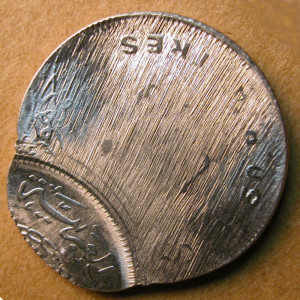Part III. Die Installation Errors:
Use of Canceled and Defaced Dies
Definition: When a die is pulled from service it is first defaced before being sent out to be recycled. When a design is retired, the remaining dies are canceled or defaced so that no further coins can be struck. Installation of a canceled or defaced die is unlikely to be an accident and the coins struck by them must be considered intentional errors.
A coin struck by canceled dies will still show most of the design, but the surface will be crossed by one or more thick ridges that may run in parallel or may intersect. These ridges represent grooves cut into the die face.
A coin struck by defaced dies will show little of the design. Surface details are replaced by a coarsely textured or lumpy surface.
No examples exist of coins struck by canceled or defaced dies within the U.S. Mint. Several examples are known from other countries. These include a bimetallic 1994 Hong Kong 10 dollar coin with two parallel ridges on each face. We also have the unique Egyptian coin described below.
This Egyptian 25 piastres planchet was first struck 80% off-center by 25 piastres dies. It was then struck within a 50 piastres collar by a pair of 2010 Egypt 50 piastres dies that had most of the design ground off. The defaced 50 piastres dies only contacted the unstruck portion of the off-center 25 piastres coin. The struck tongue was left untouched by the second strike because its reduced thickness was apparently less than the minimum die clearance of the 50 piastres press.
The 50 piastres reverse die was rotated approximately 120 degrees counterclockwise relative to the obverse die (medal rotation is normal).
The 25 piastres denomination is struck on a planchet composed of nickel-plated steel while the 50 piastres design is normally struck on a planchet composed of brass-plated steel. We therefore have in this double-denomination error the rare trifecta of a planchet error (off-metal/wrong planchet), a die error (defaced), and a striking error (off-center first strike and rotated die error on second strike).

